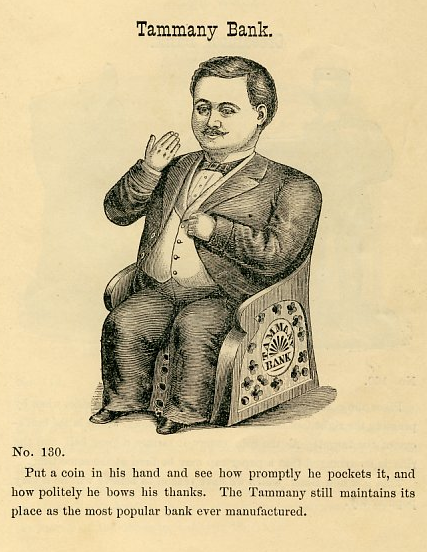When John and Elisha Stevens formed the J & E Stevens Company in Cromwell in 1843, they intended to manufacture cast-iron hardware, hammers, and a few iron toys. The success the brothers found in producing those few iron toys changed their business plan: the J & E Stevens Company eventually became the largest manufacturer of cast-iron toys in the country.

J. & E. Stevens advertisement, ca. 1851
With their 1859 introduction of the first fire cracker pistol, the brothers began focusing almost exclusively on toy production. Their product line included toy cannons, locomotives, and whistling tops. Though the brothers marketed their products primarily to boys, they also made toy stoves, furniture, and miniature cutlery that they marketed to young girls.
A turning point in the company’s development came in 1869 with the production of their first cast-iron mechanical bank. This bank, featuring a monkey that popped out of building, inspired numerous competitors to produce similar products and helped create a new genre of product that blended art and function in ways that sparked the imagination and ingenuity of designers. In fact, between 1869 and 1890, the J & E Stevens Company produced more than 300 different models of mechanical banks.
Company’s Playthings become Coveted Collectibles
Changing times and changing tastes drove the evolution of the J & E Stevens Company. By 1928, the company began devoting itself exclusively to the production of cap pistols. These toys, along with those of local competitors, found their way to store shelves all over the country by the start of the Second World War. World War II production needs, however, created an iron shortage that abruptly brought an end to the J & E Stevens Company, with Buckley Brothers of New York eventually purchasing the company in 1950.
Despite bringing an end to their production, the economic ramifications of World War II brought renewed interest in cast-iron toys. Toy collecting, which became popular in the 1920s, exploded in the post-war era thanks to increases in spendable income. Today, original cast-iron banks and toys from the J & E Stevens Company sell for thousands of dollars. The enduring value of these products is a testament to the quality and ingenuity that helped make Connecticut the nation’s leading toy producer for much of the 19th century.
 Tammany Bank, J. & E. Stevens Co. |
 No. 130 Tammany Bank, 1878 J. & E. Stevens Co. catalog |








